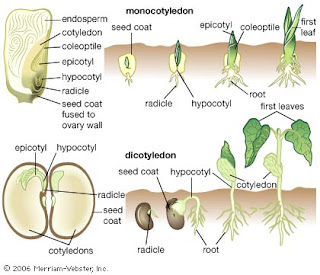-In monocot plants, the first shoot that emerges from the ground or from the seed is the epicotyl, from which the first shoots and leaves emerge.
-The radicle aborts, and new roots arise adventitiously.
-Some monocots, such as grasses, have hypogeal emergence, where the mesocotyl elongates and pushes the coleoptile (which encloses and protects the shoot tip) toward the soil surface. Since elongation occurs above the cotyledon, it is left in place in the soil where it was planted.
-Has two seed leaves (cotyledons)
-In dicots, the hypocotyl is what appears to be the base stem under the spent withered cotyledons, and the shoot just above that is the epicotyl.
-Roots grow from the radical and apical meristem.
-Many dicots have epigeal emergence, in which the hypocotyl elongates and becomes arched in the soil. -As the hypocotyl continues to elongate, it pulls the cotyledons upward, above the soil surface
-wheat, rice, sugar cane, grass, tulip, lily
Related Species to Beans:
-sunflower family, rose famil, grapes, strawberries, tomatoes











